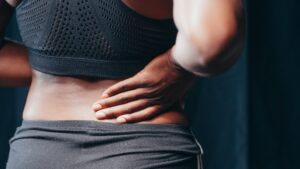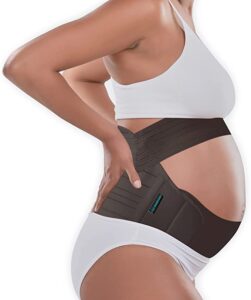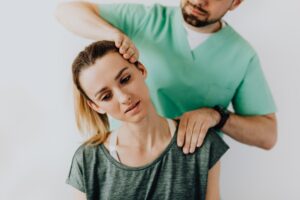Pelvic Girdle Pain (PGP) has been thought of, for many years, as ‘just a normal part of pregnancy’. We are often told that it will resolve once the baby comes and to ‘just avoid painful activities’ until then. For this reason, we wanted to look at how PGP really impacts the lives of ladies suffering with it throughout their pregnancies and beyond and if anything can actually be done to help them.
What is Pelvic Girdle Pain?
Pelvic Girdle Pain is any pain that is related to your pelvis (an umbrella term), it is also sometimes known as Synthesis Pubis Dysfunction (which is less accurate as that suggests that only the Pubic joint is involved and this is usually not the case). It was previously thought that PGP was caused by the hormone Relaxin, (which is produced during the female reproductive cycle and increases once pregnancy occurs) but this led to the false belief that PGP should resolve at the time of birth or shortly after, which we know is not always the case. A study by Aldabe et al. in 2012 found that there was actually a poor relationship between Relaxin and PGP, this led to further studies looking into other possible causes.
PGP can appear at any stage during pregnancy and as Physiotherapists we often see ladies 1-2 years post birth, still suffering with the condition. Symptoms can occur after physical activity or after a slip into an awkward position, meaning that Pelvic girdle symptoms are more likely to occur due to a mechanical fault than a hormone issue. The main risk factors for developing PGP without trauma are:
- A history of Lower Back Pain.
- Previous injury to the pelvis or surrounding muscles.
- Previous births.
- Carrying more than 1 baby.
What symptoms come with Pelvic Girdle Pain?
Symptoms are never the same from one lady to the next but there will usually be similarities reported. Symptoms might include:
- Pain over the pubic bone, lower back, in the area between vagina and anus and occasionally into the thighs.
- A sensation of clicking or grinding in the pelvis.
- Pain with single leg activities or separating the legs outwards from one another i.e., climbing stairs, turning over in bed, getting out of the car, getting dressed (putting trousers on).
So, is it Pelvic Girdle pain or Lower back pain?

PGP and low back pain are often mistaken for one another. It can be quite difficult to distinguish between the two but there are a few signs to look for:
- PGP is often considered more painful than lower back pain (but you would have to have had back pain in the past to compare the two).
- PGP is more intermittent and specific to certain movements like walking, bending, climbing stairs and getting dressed (i.e., balancing on one leg).
- Pain from PGP can be in the lower back but is often also in the pubic symphysis region.
Why is Pelvic Girdle Pain a big deal then?
The emotional impact of PGP, due to the resulting pain and disability, can be high and many pregnant women with PGP feel that they are not taken seriously by healthcare professionals. Qualitative studies investigating the experience of PGP have uncovered feelings of frustration and helplessness (Crichton and Wellock, 2008), anxiety and worry about the birth (Elden et al., 2014) and social and psychological challenges especially for those who continue to suffer from PGP after the birth (Engeset et al., 2014). In 2018 researchers Mackenzie et al, gathered lots of data and carried out a systematic review exploring the experiences of ladies with PGP and the associated psychological effects. They reported that Health Professionals working with these pregnant and postnatal women were not aware of the anger, frustration and negative emotions that were resulting from the reported PGP. They also found that many women were becoming socially isolated due to their symptoms and were at higher risk of abusing analgesics in attempt to manage their pain.
Does anything actually help?
When you look online for the best treatments for PGP you will get a lot of conflicting advice or a long list of different things to try (which not everyone has time to do). We have looked in detail at the most recent research on this topic to provide more accurate treatment advice. This is what the research says about the following treatment options:
Pelvic Support Belts
Rodriguez and Troynikov carried out a detailed systematic review of relevant literature in 2019, looking at the effectiveness of pelvic support belts. They reported that wearing the belt during pregnancy was likely to have beneficial effects. They found pain reduction in the back and pelvic regions, improvement of functionality and mobility, and reduction of risk of falling during use in pregnancy.
The writers also reported on the multiple types of commercially available maternity support garments. They noted that manufacturers were claiming to provide different benefits and comfort improvement to the wearer through the design, materials, and/or constructions of their garments, however, the researchers found that none provided scientific evidence to support their claims.
Here is a good example of a maternity support belt that has over 6000 really good reviews.
Yoga
Another interesting study looked into the effects of yoga on Pelvic Girdle Pain. Kawanashi et al in 2015 found that prenatal yoga may help reduce pelvic pain. During their study they also found that yoga can improve mental condition (stress, depression, anxiety), physical condition (pain and pleasure at the delivery), and perinatal outcomes (obstetrical complications and delivery time).
There are lots of Online Yoga programmes available, have a look at our Top 5 here (and why we love them)!

Stabilising Exercises
Almousa et al published a paper in 2018 which reported on the effectiveness of stabilising exercises in pelvic girdle pain during pregnancy and after delivery. They carried out a comprehensive systematic review and found that stabilising exercises decrease pain and improve the quality of life for pregnant women, when they are carried out on a regular basis. They also reported some limited evidence that stabilising exercises decrease pain for postpartum women too although they did note, that the evidence for this type of treatment is limited and more studies are needed to draw a more confident conclusion.
Have a look at our Top 5 Online Pilates programmes here.
TENS
Evidence is in favour of the use of TENS in the treatment of PGP. THIS study is a Randomised Controlled Trial (RCT) that looked into the differences in outcome between acupuncture and transcutaneous electrical nerve stimulation (TENS) as treatment options for pelvic girdle pain. In this trial by Ekdahl et al (2020) it was reported that treating PGP with acupuncture or TENS resulted in maintenance of functioning and physical activity and also less pain and concern about pain. They concluded that ‘Either intervention could be recommended as a non-pharmacological alternative for pain relief and may enable pregnant women to stay active’.
It is recommended that you discuss the use of TENS with your healthcare provider to ensure that it is the right course of treatment for you and your baby. There are many different TENS machines available to buy, so if you are thinking of TENS as a treatment option then have a look at our Top 5 picks to make things a little easier.
Manual Therapies
We found a really interesting study on this topic that was published in 2016 by authors Hall et al. They carried out a systematic review and meta-analysis on ‘The effectiveness of complementary manual therapies for pregnancy-related back and pelvic pain’. They looked at 348 records which included 1198 pregnant ladies and concluded that there was very limited evidence to support the use of complementary manual therapies as an option for managing low back and pelvic pain during pregnancy. The therapeutic interventions predominantly involved massage and osteopathic manipulative therapy. Their meta-analyses found positive effects for manual therapy on pain intensity when compared to usual care and relaxation but not when compared to sham interventions.
Aquatic Exercise
Authors Ali, Azam and Askry (2020) carried out a systematic review on the effects of aquatic exercise in treating pregnancy related issues. The review suggests that the evidence available was quite scarce but the authors concluded that this form of exercise appeared to be beneficial for improvements in back pain, maternal discomfort, pelvic pain, fatigue, labour pain and oedema related pain. In this review, aquatic exercise was simply defined as all type of physical activities and exercise programmes that were designed to be performed in water.

Advice from a Physiotherapy point of view:
Additional advice that we would add to these findings and provide to our patients would be the following:
- Place a pillow between your legs before sleeping.
- Sleep on your side with your legs bent.
- Stay active but only do activities where both feet remain on the floor at the same time.
- Wear flat, supportive shoes where possible.
- Get dressed sitting down.
- Avoid breaststroke if you go swimming.
- Avoid standing on one leg for long periods of time.
- Keep your knees together while getting in or out of the car / bed.
In Conclusion
Pelvic Girdle Pain can be anywhere on the scale from mild to severe and can affect pregnant and postnatal ladies in very different ways. Mild symptoms to one lady can be devastating due to their inability to carry out their usual activities / sports but could be easily managed by others who might be less active. Research suggests that there are things that can help in the short term, like the maternity support belts and TENS machines (which can resolve the issue if it doesn’t persist after birth) and some things that might help more in the long term like aquatic exercise and yoga during the pregnancy. The main thing to take from all of this is that trying any of the above is likely to be much better than doing nothing (as is often advised).






